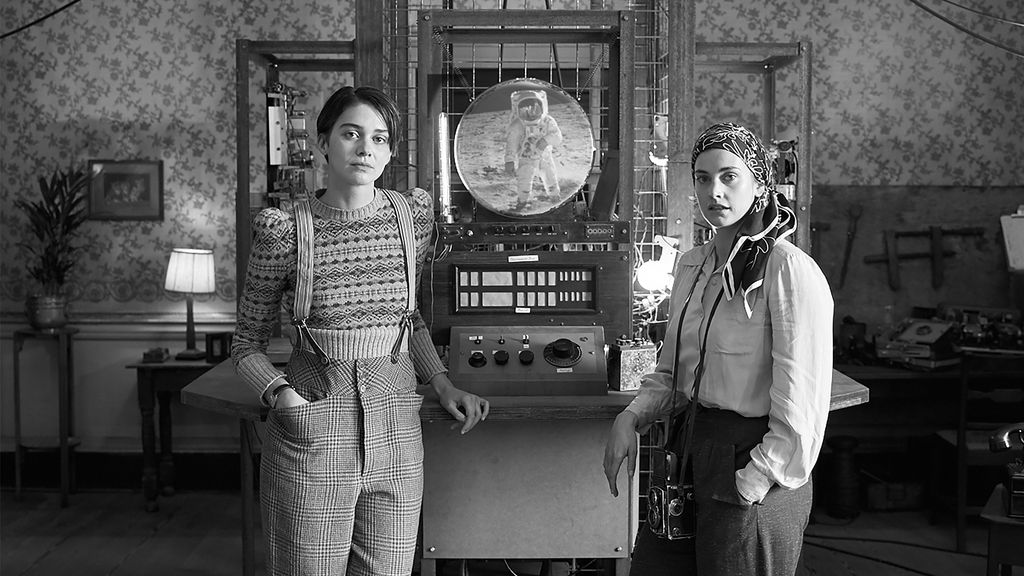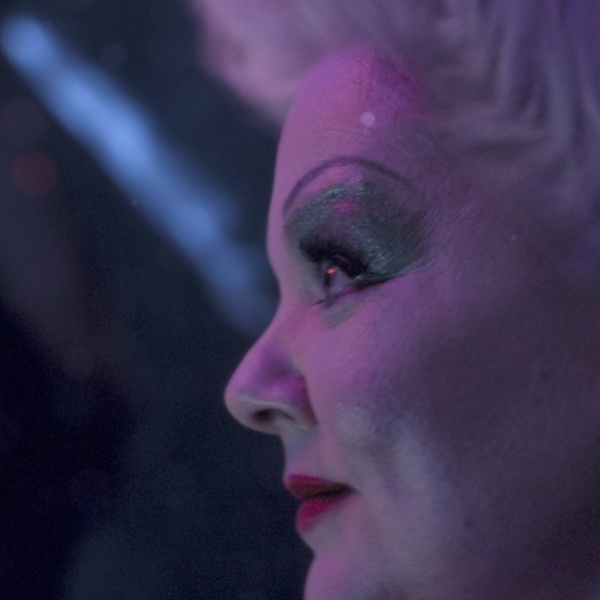Editor’s note: This review was originally published at the 2022 Locarno Film Festival. Dark Sky Films releases the film in theaters and on VOD on Friday, August 4.
An immensely clever and resourceful micro-budget movie about time-travel in the tradition of “La Jetée,” “Primer,” and last year’s loopy Japanese wonder “Beyond the Infinite Two Minutes,” Andrew Legge’s collage-like “LOLA” seamlessly combines authentic World War II-era newsreels together with fictional home videos to create a (very modern) found footage sci-fi story that strives to feel like it could have been made by someone in 1941, or at least by Guy Maddin in 2006.
The premise is tantalizing enough to keep your imagination tickled for most of the film’s brisk 79-minute running time: In 2021, a mystery cache of meticulously edited old celluloid was discovered in the cellar of a Sussex country house that once belonged to Martha and Thomasina Hanbury (played by Stefani Martini and Emma Appleton, respectively). It contained a first-person documentary about two beautiful and brilliant sisters who invented a machine that intercepted radio waves from the future, dubbed the device “LOLA,” and then used their towering, Oscilloscope-like device contraption to watch glimpses of the world to come.
With LOLA’s power, Martha and Thomasina fell in love with David Bowie’s music before he was born, obsessed about Stanley Kubrick movies before they were shot, and learned about female empowerment at a time when many young women their age were still half-stuck in the Victorian Era. They also used LOLA to help Britain stay one step ahead of the Nazis, a plan that seems to have backfired so badly that Martha felt compelled to make this film as some kind of cautionary tale for her sister — a plea to stop the madness before they ran out of time. “I want to show you how history can be made, and unmade,” Martha’s words crackle over the phonograph-quality voiceover track, as Legge’s debut cuts back to the days of LOLA’s creation and then rockets forward from there at the speed of a newspaper spinning towards the screen.
Shot by Oona Menges in fuzzy monochrome (her images adorned with perforated edges, artificial damage, and various other kinds of digital wear-and-tear to make it seem like it’s been sitting in a box for the better part of a century), and scored by The Divine Comedy frontman Neil Hannon (whose percussive harpsichord bangers lend the first half of Legge’s film its shape, and whose parallel universe Fascist pop songs about the sound of marching feet and the perils of “fraternizing with perverts” lend the second half of Legge’s film its sly comedy), “LOLA” scrubs through the years with little regard for conventional drama. Everything is conveyed in hindsight, and with the cheery restraint of a report from the frontlines. It makes sense that Martha’s narration would neither be overly impressed with LOLA’s creation nor surprised that she and her sister were smart enough to invent it, and so the movie “she’s making” is free to adopt a factual approach that allows it to skip ahead to its implications.
It’s a good thing that Martini and Appleton exude palpable screen presences, as the form of Legge’s film doesn’t allow them to do much else. The snatches of footage we see are enough to glean that Martha was the more sociable and open-hearted of the Hanbury sisters, while the brooding Thomasina — dangerously in the thrall of her own brilliance — was less romantic in her notions of science and humanity. But the difference between them isn’t given a chance to run much deeper than light and dark, blonde and brunette, as Legge and his co-writer Angeli Macfarlane are having too much fun dubbing over archival footage (so that actual 1940s politicians appear to be thanking the anonymous “Angel of Portobello” who warned them of impending Nazi strikes) and pushing the sisters to make “Dr. Strangelove” references that only they would understand.
If that fun isn’t always contagious, the creative fizz of Legge’s masterful pastiche is strong enough to keep “LOLA” moving along at a steady clip, and also to reward the director’s lifelong fascination with the intersection between fatalism and invention (his previous work includes a 2009 short called “The Chronoscope,” about a fictional Irish scientist whose signature machine could see into the past). Almost too self-aware that it’s always on the verge of overstaying its welcome, “LOLA” zips from one cute anachronism to the next without much of an emotional core, as Legge is so in love with his primary conceit that a more conventional narrative might threaten to distract from its potential.
Which isn’t to say that “LOLA” doesn’t have a plot — Martha even gets a significant romance — only that the ingenuity of re-contextualizing WWII propaganda footage (for example) often feels like the main attraction. That works for the film when it’s still having fun, like it is during the scene when the sisters introduce a stuffy mid-century crowd to The Kinks, but the seams begin to show once Martha and Thomasina are separated from each other, history tilts off its axis, and “LOLA” succumbs to the simpler demands of its story.
The genius of Legge’s design, and why his debut works as more than just a cute little curio despite its thinness, is that it mines a sneaky emotionality from the bedrock of the film-within-a-film structure. One sister sees LOLA as a window, the other as a weapon. In its dying moments, which are somehow inevitable and surprising in almost equal measure, “LOLA” reconciles that disconnect with a feather-light gut-punch of a finale. Inventing the future is one thing, living in it quite another.
Grade: B
“LOLA” premiered at the 2022 Locarno Film Festival.



